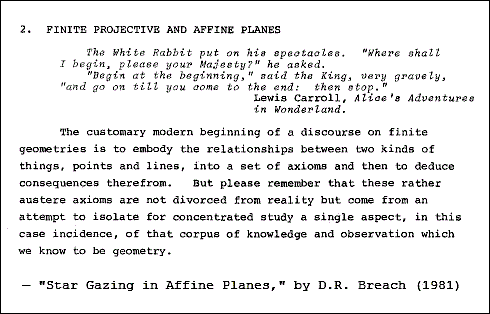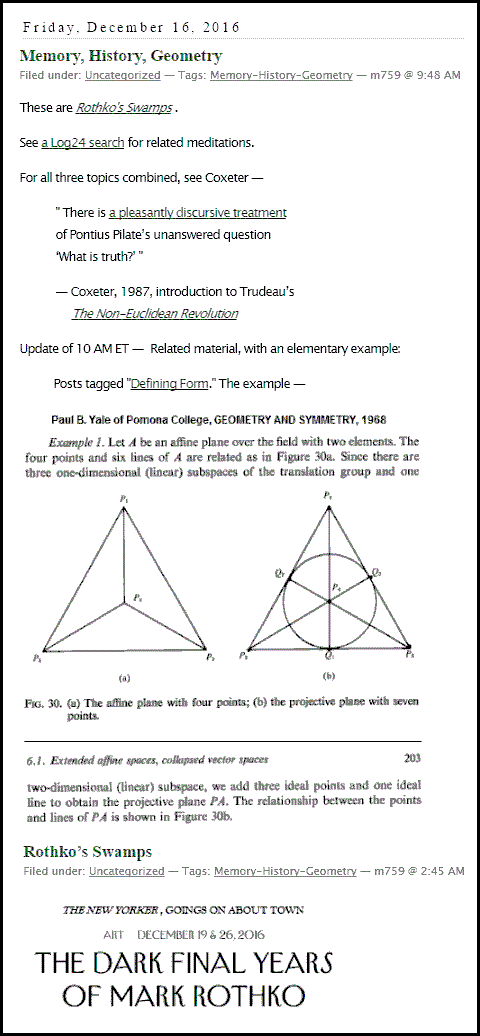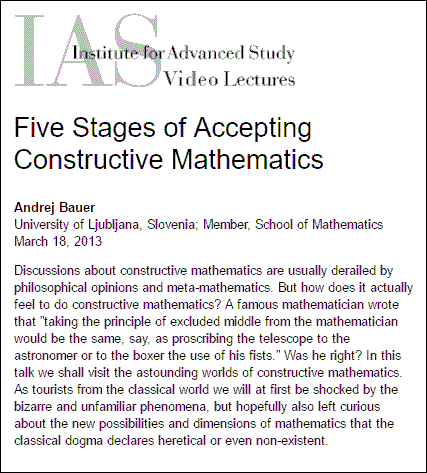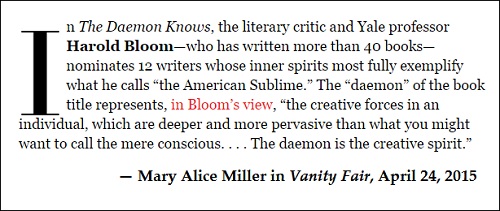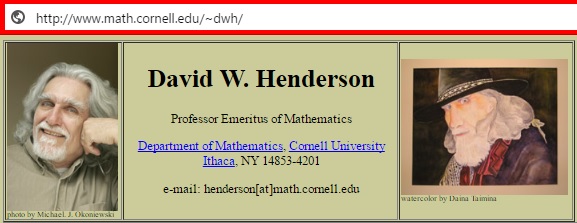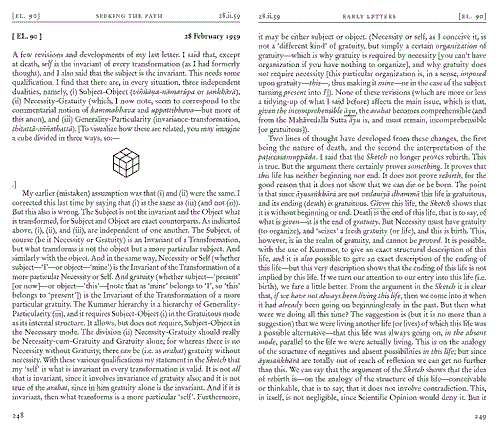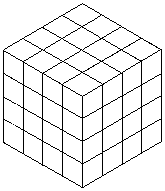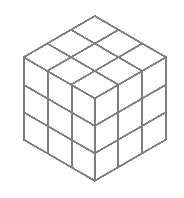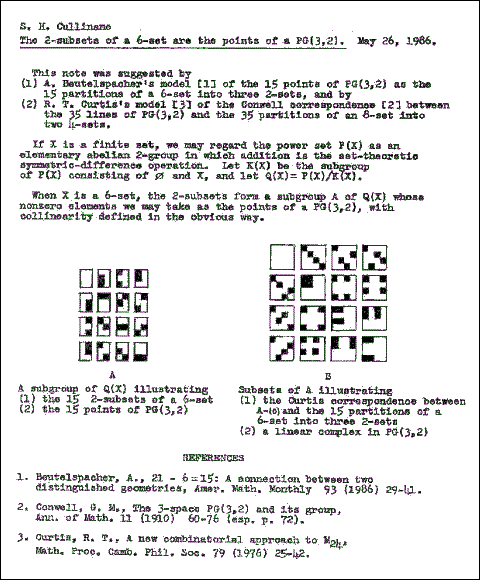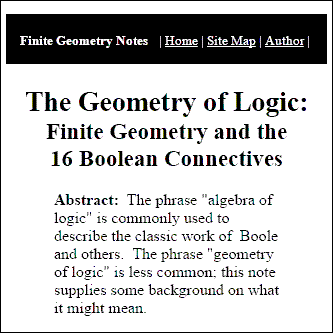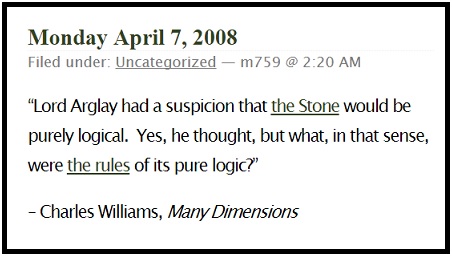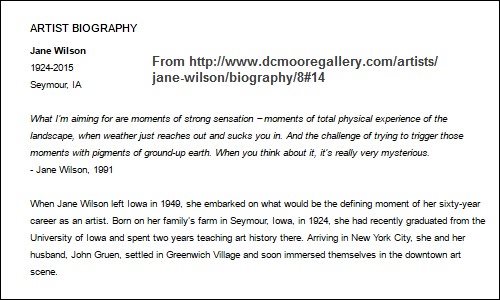Breach's 1981 approach is not axiomatic,
but instead graphic. Another such approach —
Saturday, December 31, 2016
Habeas
Rogue One’s Opening Date
Tuesday, December 27, 2016
Bright Star
See instances of the title in this journal.
Material related to yesterday evening's post
"Bright and Dark at Christmas" —
The Buddha of Rochester:
See also the Gelman (i.e., Gell-Mann) Prize
in the film "Dark Matter" and the word "Eightfold"
in this journal.
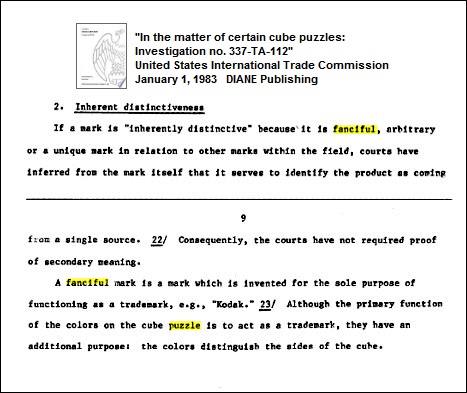
" A fanciful mark is a mark which is invented
for the sole purpose of functioning as a trademark,
e.g., 'Kodak.' "
"… don't take my Kodachrome away." — Paul Simon
Sunday, December 25, 2016
Credit Where Due
Saturday, December 24, 2016
Early X Piece
In memory of an American artist whose work resembles that of
the Soviet constructivist Karl Ioganson (c. 1890-1929).
The American artist reportedly died on Thursday, Dec. 22, 2016.
|
"In fact, the (re-)discovery of this novel structural principle was made in 1948-49 by a young American artist whom Koleichuk also mentions, Kenneth Snelson. In the summer of 1948, Snelson had gone to study with Joseph Albers who was then teaching at Black Mountain College. . . . One of the first works he made upon his return home was Early X Piece which he dates to December 1948 . . . . "
— "In the Laboratory of Constructivism: |
The word "constructivism" also refers to a philosophy of mathematics.
See a Log24 post, "Constructivist Witness," of 1 AM ET on the above
date of death.
Friday, December 23, 2016
Memory, History, Geometry
Code Blue

Update of 7:04 PM ET —
The source of the 404 message in the browsing history above
was the footnote below:
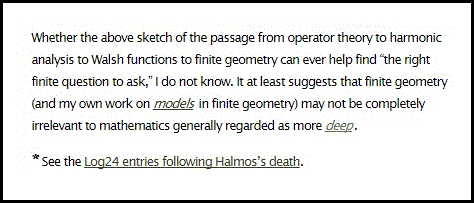
Requiem for a Mathematician
From a Dec. 21 obituary posted by the
University of Tennessee at Knoxville —
"Wade was ordained as a pastor and served
at Oakwood Baptist Church in Knoxville."
Other information —

In a Log24 post, "Seeing the Finite Structure,"
of August 16, 2008, Wade appeared as a co-author
of the Walsh series book mentioned above —

Walsh Series: An Introduction
to Dyadic Harmonic Analysis,
by F. Schipp et al.,
Taylor & Francis, 1990
From the 2008 post —
The patterns on the faces of the cube on the cover
of Walsh Series above illustrate both the
Walsh functions of order 3 and the same structure
in a different guise, subspaces of the affine 3-space
over the binary field. For a note on the relationship
of Walsh functions to finite geometry, see
Symmetry of Walsh Functions.
Thursday, December 22, 2016
The Laugh-Hospital
See also, from the above publication date, Hudson's Inscape.
The inscape is illustrated in posts now tagged Laughing Academy.
Constructivist Witness
The title refers to a philosophy of mathematics.
For those who prefer metaphor… Folk Etymology.
See also Stages of Math at Princeton's
Institute for Advanced Study in March 2013 —
— and in this journal starting in August 2014.
Wednesday, December 21, 2016
Space Itself
Consider Stevens’s verse from “The Rock” (1954):
“That in which space itself is contained.”
Consider also Whitehead in 1906 —
"This is proved by the consideration
of a three dimensional geometry in which
there are only fifteen points."
— and Stevens on the sublime (1935):
"And the sublime comes down
To the spirit itself,
The spirit and space,
The empty spirit
In vacant space."
Tuesday, December 20, 2016
Enumerating Entities

See also a Terry Gilliam film on "crunching entities."
Monday, December 19, 2016
Tetrahedral Cayley-Salmon Model
The figure below is one approach to the exercise
posted here on December 10, 2016.

Some background from earlier posts —
Click the image below to enlarge it.
Sunday, December 18, 2016
Sunday Dinner Crumbs
From posts now tagged “Memory-History-Geometry” —
“… even the dogs under the table
eat the children’s crumbs.” — Mark 7:28
From a 2015 post …
“… Kansas and Harvard officially met
as Kansas wrestled the unsuspecting Harvard
to the ground in a headlock.”
— Harvard Heart of Gold , by Dustin Aguilar,
quoted here on April 24, 2015
For the dogs under the table, a note from that same date —
See as well Tom Wolfe on manifestos
and “the creative spirit.”
Two Models of the Small Desargues Configuration
Saturday, December 17, 2016
Tetrahedral Death Star
Continuing the "Memory, History, Geometry" theme
from yesterday …
See Tetrahedral, Oblivion, and Tetrahedral Oblivion.
"Welcome home, Jack."
Friday, December 16, 2016
Memory, History, Geometry
These are Rothko's Swamps .
See a Log24 search for related meditations.
For all three topics combined, see Coxeter —
" There is a pleasantly discursive treatment
of Pontius Pilate’s unanswered question
‘What is truth?’ "
— Coxeter, 1987, introduction to Trudeau’s
The Non-Euclidean Revolution
Update of 10 AM ET — Related material, with an elementary example:
Posts tagged "Defining Form." The example —
Rothko’s Swamps
“… you don’t write off an aging loved one
just because he or she becomes cranky.”
— Peter Schjeldahl on Rothko in The New Yorker ,
issue dated December 19 & 26, 2016, page 27
He was cranky in his forties too —
See Rothko + Swamp in this journal.
Related attitude —
From Subway Art for Times Square Church , Nov. 7
Tuesday, December 13, 2016
The Thirteenth Novel
John Updike on Don DeLillo's thirteenth novel, Cosmopolis —
" DeLillo’s post-Christian search for 'an order at some deep level'
has brought him to global computerization:
'the zero-oneness of the world, the digital imperative . . . . ' "
— The New Yorker , issue dated March 31, 2003
On that date ….
Related remark —
" There is a pleasantly discursive treatment
of Pontius Pilate’s unanswered question
‘What is truth?’ "
— Coxeter, 1987, introduction to Trudeau’s
The Non-Euclidean Revolution
Monday, December 12, 2016
Sunday, December 11, 2016
Complexity to Simplicity via Hudson and Rosenhain*
*The Hudson of the title is the author of Kummer's Quartic Surface (1905).
The Rosenhain of the title is the author for whom Hudson's 4×4 diagrams
of "Rosenhain tetrads" are named. For the "complexity to simplicity" of
the title, see Roger Fry in the previous post.
Complexity to Simplicity
Cézanne "showed how it was possible to pass
from the complexity of the appearance of things
to the geometrical simplicity which design demands."
— Roger Fry in the catalogue for the 1910 London
exhibition "Manet and the Post-Impressionists,"
according to …
See also A Roger Fry Reader
(edited by Christopher Reed,
University of Chicago Press, 1996).
Saturday, December 10, 2016
Folk Etymology
Images from Burkard Polster's Geometrical Picture Book —

See as well in this journal the large Desargues configuration, with
15 points and 20 lines instead of 10 points and 10 lines as above.
Exercise: Can the large Desargues configuration be formed
by adding 5 points and 10 lines to the above Polster model
of the small configuration in such a way as to preserve
the small-configuration model's striking symmetry?
(Note: The related figure below from May 21, 2014, is not
necessarily very helpful. Try the Wolfram Demonstrations
model, which requires a free player download.)
Labeling the Tetrahedral Model (Click to enlarge) —
Related folk etymology (see point a above) —
Related literature —
The concept of "fire in the center" at The New Yorker ,
issue dated December 12, 2016, on pages 38-39 in the
poem by Marsha de la O titled "A Natural History of Light."
Cézanne's Greetings.
Friday, December 9, 2016
Snow Dance
See Ballet Blanc in this journal.
For a darker perspective, click on the image below.
See also Cartier in The Hexagon of Opposition.
Happy birthday to Kirk Douglas.
Thursday, December 8, 2016
Finite Groups and Their Geometric Representations
The title is that of a presentation by Arnold Emch
at the 1928 International Congress of Mathematicians:
See also yesterday's "Emch as a Forerunner of S(5, 8, 24)."
Related material: Diamond Theory in 1937.
Further remarks: Christmas 2013 and the fact that
759 × 322,560 = the order of the large Mathieu group M24 .

Wednesday, December 7, 2016
Spreads and Conwell’s Heptads
For a concise historical summary of the interplay between
the geometry of an 8-set and that of a 16-set that is
involved in the the Miracle Octad Generator approach
to the large Mathieu group M24, see Section 2 of …
Alan R. Prince
A near projective plane of order 6 (pp. 97-105)
Innovations in Incidence Geometry
Volume 13 (Spring/Fall 2013).
This interplay, notably discussed by Conwell and
by Edge, involves spreads and Conwell’s heptads .
Update, morning of the following day (7:07 ET) — related material:

See also “56 spreads” in this journal.
Emch as a Forerunner of S(5, 8, 24)

Commentary —
|
"The close relationships between group theory and structural combinatorics go back well over a century. Given a combinatorial object, it is natural to consider its automorphism group. Conversely, given a group, there may be a nice object upon which it acts. If the group is given as a group of permutations of some set, it is natural to try to regard the elements of that set as the points of some structure which can be at least partially visualized. For example, in 1861 Mathieu… discovered five multiply transitive permutation groups. These were constructed as groups of permutations of 11, 12, 22, 23 or 24 points, by means of detailed calculations. In a little-known 1931 paper of Carmichael [5], they were first observed to be automorphism groups of exquisite finite geometries. This fact was rediscovered soon afterwards by Witt [11], who provided direct constructions for the groups and then the geometries. It is now more customary to construct first the designs, and then the groups…."
5. R. D. Carmichael, Tactical configurations of rank two,
11. E. Witt, Die 5-fach transitiven Gruppen von Mathieu,
— William M. Kantor, book review (pdf), |
Monday, December 5, 2016
Thursday, December 1, 2016
Wednesday, November 30, 2016
In Nuce
|
Excerpts from James C. Nohrnberg, "The Master of the Myth of Literature: An Interpenetrative Ogdoad for Northrop Frye," Comparative Literature Vol. 53, No. 1 (Winter, 2001), pp. 58-82
From page 58 — * P. 22 of Rereading Frye: The Published and Unpublished Works , ed. David Boyd and Imre Salusinszky, Frye Studies [series] (Toronto: University of Toronto Press, 1998). [Abbreviated as RF .]
From page 62 —
From page 63 —
From page 69 —
From page 71 —
From page 77 — |
Sunday, November 27, 2016
Friday, November 25, 2016
Priority
Before the monograph "Diamond Theory" was distributed in 1976,
two (at least) notable figures were published that illustrate
symmetry properties of the 4×4 square:
Hudson in 1905 —
Golomb in 1967 —

It is also likely that some figures illustrating Walsh functions as
two-color square arrays were published prior to 1976.
Update of Dec. 7, 2016 —
The earlier 1950's diagrams of Veitch and Karnaugh used the
1's and 0's of Boole, not those of Galois.
Wednesday, November 23, 2016
Yogiism
From the American Mathematical Society (AMS) webpage today —
From the current AMS Notices —
Related material from a post of Aug. 6, 2014 —

(Here "five point sets" should be "five-point sets.")
From Gotay and Isenberg, “The Symplectization of Science,”
Gazette des Mathématiciens 54, 59-79 (1992):
“… what is the origin of the unusual name ‘symplectic’? ….
Its mathematical usage is due to Hermann Weyl who,
in an effort to avoid a certain semantic confusion, renamed
the then obscure ‘line complex group’ the ‘symplectic group.’
… the adjective ‘symplectic’ means ‘plaited together’ or ‘woven.’
This is wonderfully apt….”

The above symplectic structure* now appears in the figure
illustrating the diamond-theorem correlation in the webpage
Rosenhain and Göpel Tetrads in PG(3,2).
* The phrase as used here is a deliberate
abuse of language . For the real definition of
“symplectic structure,” see (for instance)
“Symplectic Geometry,” by Ana Cannas da Silva
(article written for Handbook of Differential
Geometry , Vol 2.) To establish that the above
figure is indeed symplectic , see the post
Zero System of July 31, 2014.
Tuesday, November 22, 2016
Jargon
See "sacerdotal jargon" in this journal.
For those who prefer scientific jargon —
"… open its reading to
combinational possibilities
outside its larger narrative flow.
The particulars of attention,
whether subjective or objective,
are unshackled through form,
and offered as a relational matrix …."
— Kent Johnson in a 1993 essay
For some science that is not just jargon, see …
and, also from posts tagged Dirac and Geometry …
The above line complex also illustrates an outer automorphism
of the symmetric group S6. See last Thursday's post "Rotman and
the Outer Automorphism."
Monday, November 21, 2016
Inner, Outer
Friday, November 18, 2016
Thursday, November 17, 2016
Rotman and the Outer Automorphism
This is a followup to Tuesday's post on the Nov. 15 American
Mathematical Society (AMS) obituary of Joseph J. Rotman.
Detail of a page in "Notes on Finite Geometry, 1978-1986,"
"An outer automorphism of S6 related to M24" —

Related work of Rotman —
"Outer Automorphisms of S6," by
Gerald Janusz and Joseph Rotman,
The American Mathematical Monthly ,
Vol. 89, No. 6 (Jun. – Jul., 1982), pp. 407-410
Some background —
"In a Nutshell: The Seed," Log24 post of Sept. 4, 2006:
Monday, November 14, 2016
Flashback
Monday, November 7, 2016
Just the Facts, Ma’am*
"After finishing high school in Miami,
Ms. Reno attended Cornell University,
graduating in 1960 with a degree in chemistry."
— The online New York Times today
An example that is blatantly not "just the facts," from a Cornell author
found via last midnight's link "Ghost Light" —
Thursday, November 3, 2016
Friday, October 28, 2016
Diamond-Theorem Application
|
Abstract: "Protection of digital content from being tapped by intruders is a crucial task in the present generation of Internet world. In this paper, we proposed an implementation of new visual secret sharing scheme for gray level images using diamond theorem correlation. A secret image has broken into 4 × 4 non overlapped blocks and patterns of diamond theorem are applied sequentially to ensure the secure image transmission. Separate diamond patterns are utilized to share the blocks of both odd and even sectors. Finally, the numerical results show that a novel secret shares are generated by using diamond theorem correlations. Histogram representations demonstrate the novelty of the proposed visual secret sharing scheme." — "New visual secret sharing scheme for gray-level images using diamond theorem correlation pattern structure," by V. Harish, N. Rajesh Kumar, and N. R. Raajan.
Published in: 2016 International Conference on Circuit, Power and Computing Technologies (ICCPCT). |
Excerpts —
Related material — Posts tagged Diamond Theorem Correlation.
Thursday, October 27, 2016
“Space Is the Place!”
Or: Pentagram Meets Counting-Pattern, Continued
Arts & Letters Daily today links to a Chronicle of Higher Education
piece on philosophy with an illustration by the late Paul Laffoley …
This suggests a review of Laffoley's work. In particular —
For a larger view of the above Laffoley pentagram, click here.
Contrast with Wittgenstein's "counting-pattern" above, which
is, in fact, a hyperspace.
Sunday, October 23, 2016
Quartet
“The man who lives in contact with what he believes to be a living Church
is a man always expecting to meet Plato and Shakespeare to-morrow
at breakfast.”
— G. K. Chesterton
Or Sunday dinner.
|
Platonic |
Shakespearean |
| Not to mention Euclid and Picasso. | |
|
|

|
|
In the above pictures, Euclid is represented by |
|
Tuesday, October 18, 2016
Parametrization
The term "parametrization," as discussed in Wikipedia,
seems useful for describing labelings that are not, at least
at first glance, of a vector-space nature.
Examples: The labelings of a 4×4 array by a blank space
plus the 15 two-subsets of a six-set (Hudson, 1905) or by a
blank plus the 5 elements and the 10 two-subsets of a five-set
(derived in 2014 from a 1906 page by Whitehead), or by
a blank plus the 15 line diagrams of the diamond theorem.
Thus "parametrization" is apparently more general than
the word "coodinatization" used by Hermann Weyl —
“This is the relativity problem: to fix objectively
a class of equivalent coordinatizations and to
ascertain the group of transformations S
mediating between them.”
— Hermann Weyl, The Classical Groups ,
Princeton University Press, 1946, p. 16
Note, however, that Weyl's definition of "coordinatization"
is not limited to vector-space coordinates. He describes it
as simply a mapping to a set of reproducible symbols .
(But Weyl does imply that these symbols should, like vector-space
coordinates, admit a group of transformations among themselves
that can be used to describe transformations of the point-space
being coordinatized.)
Saturday, October 15, 2016
A Marxist Perspective
The previous post, Nobel Perspective, suggests a review of
the following passage pictured here on August 27, 2013.
Click image for a better view of the original.
There are, of course, more sophisticated approaches
to the place of perspective in the history of art.
Wednesday, October 12, 2016
Elementary Art

The above cycle may have influenced the design
of Carl Jung's symbol of the self —
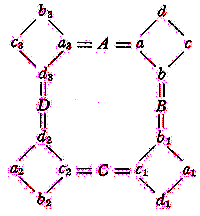
![]()
Related art by
Steven H. Cullinane
See also Levi-Strauss Formula in this journal.
Monday, October 10, 2016
Mono Type 1, by Sultan (1966)
"Sultan" was a pseudonym of Peter Lindbergh, now a
well-known fashion photographer. Click image for the source.
Related art — Diamond Theory Roullete, by Radames Ajna,
2013 (Processing code at ReCode Project based on
"Diamond Theory" by Steven H. Cullinane, 1977).
Saturday, October 8, 2016
Unity of Opposites: Plato and Beyond
The "unity" of the title was suggested by this morning's update
at the end of yesterday's post Paz.
For the Plato of the title, see the Sept. 27, 2016, post
Chomsky and Lévi-Strauss in China
Or: Philosophy for Jews
For glyphs representing the "unity of opposites" of the title,
see a webpage linked to here on Groundhog Day 2014 —
The above image is related to Jung's remarks on Coincidentia
Oppositorum . (See also coincidentia in this journal.)
A different Jung, in a new video with analogues of the rapidly
flashing images in Ajna's webpage "Diamond Theory Roullete" —
The above video promotes Google's new open-source "Noto" font —

Thursday, October 6, 2016
Key to All Mythologies…
According to Octavio Paz and Claude Lévi-Strauss
"Poetry…. conceives of the text as a series of transparent strata
within which the various parts—the different verbal and semantic
currents— produce momentary configurations as they intertwine
or break apart, as they reflect each other or efface each other.
Poetry contemplates itself, fuses with itself, and obliterates itself
in the crystallizations of language. Apparitions, metamorphoses,
volatilizations, precipitations of presences. These configurations
are crystallized time…."
— Octavio Paz in The Monkey Grammarian (written in 1970)
"Strata" also seem to underlie the Lévi-Strauss "canonic formula" of myth
in its original 1955 context, described as that of permutation groups —

I do not recommend trying to make sense of the above "formula."
Related material —
Wednesday, October 5, 2016
Sources
From a Google image search yesterday —

Sources (left to right, top to bottom) —
Math Guy (July 16, 2014)
The Galois Tesseract (Sept. 1, 2011)
The Full Force of Roman Law (April 21, 2014)
A Great Moonshine (Sept. 25, 2015)
A Point of Identity (August 8, 2016)
Pascal via Curtis (April 6, 2013)
Correspondences (August 6, 2011)
Symmetric Generation (Sept. 21, 2011)
Tuesday, October 4, 2016
Square Ice
The discovery of "square ice" is discussed in
Nature 519, 443–445 (26 March 2015).
Remarks related, if only by squareness —
this journal on that same date, 26 March 2015 —

The above figure is part of a Log24 discussion of the fact that
adjacency in the set of 16 vertices of a hypercube is isomorphic to
adjacency in the set of 16 subsquares of a square 4×4 array,
provided that opposite sides of the array are identified. When
this fact was first observed, I do not know. It is implicit, although
not stated explicitly, in the 1950 paper by H.S.M. Coxeter from
which the above figure is adapted (blue dots added).
Monday, October 3, 2016
Ein Eck
Friday, July 11, 2014
|
Hudson’s Inscape
Yesterday evening's post Some Old Philosophy from Rome
(a reference, of course, to a Wallace Stevens poem)
had a link to posts now tagged Wittgenstein's Pentagram.
For a sequel to those posts, see posts with the term Inscape ,
a mathematical concept related to a pentagram-like shape.
The inscape concept is also, as shown by R. W. H. T. Hudson
in 1904, related to the square array of points I use to picture
PG(3,2), the projective 3-space over the 2-element field.
Sunday, October 2, 2016
Westworld
On a new HBO series that opens at 9 PM ET tonight —
|
Watching Westworld , you can sense a grand mythology unfolding before your eyes. The show’s biggest strength is its world-building, an aspect of screenwriting that many television series have botched before. Often shows will rush viewers into plot, forgetting to instill a sense of place and of history, that you’re watching something that doesn’t just exist in a vacuum but rather is part of some larger ecosystem. Not since Lost can I remember a TV show so committed to immersing its audience into the physical space it inhabits. (Indeed, Westworld can also be viewed as a meta commentary on the art of screenwriting itself: brainstorming narratives, building characters, all for the amusement of other people.) Westworld is especially impressive because it builds two worlds at once: the Western theme park and the futuristic workplace. The Western half of Westworld might be the more purely entertaining of the two, with its shootouts and heists and chases through sublime desert vistas. Behind the scenes, the theme park’s workers show how the robot sausage is made. And as a dystopian office drama, the show does something truly original. — Adam Epstein at QUARTZ, October 1, 2016 |
"… committed to immersing its audience
into the physical space it inhabits…."
See also, in this journal, the Mimsy Cube —
|
"Mimsy Were the Borogoves," "… he lifted a square, transparent crystal block, small enough to cup in his palm– much too small to contain the maze of apparatus within it. In a moment Scott had solved that problem. The crystal was a sort of magnifying glass, vastly enlarging the things inside the block. Strange things they were, too. Miniature people, for example– They moved. Like clockwork automatons, though much more smoothly. It was rather like watching a play." |
Tuesday, September 27, 2016
Chomsky and Lévi-Strauss in China
Or: Philosophy for Jews
From a New Yorker weblog post dated Dec. 6, 2012 —
"Happy Birthday, Noam Chomsky" by Gary Marcus—
"… two titans facing off, with Chomsky, as ever,
defining the contest"
"Chomsky sees himself, correctly, as continuing
a conversation that goes back to Plato, especially
the Meno dialogue, in which a slave boy is
revealed by Socrates to know truths about
geometry that he hadn’t realized he knew."
Socrates and the slave boy discussed a rather elementary "truth
about geometry" — A diamond inscribed in a square has area 2
(and side the square root of 2) if the square itself has area 4
(and side 2).

Consider that not-particularly-deep structure from the Meno dialogue
in the light of the following…


The following analysis of the Meno diagram from yesterday's
post "The Embedding" contradicts the Lévi-Strauss dictum on
the impossibility of going beyond a simple binary opposition.
(The Chinese word taiji denotes the fundamental concept in
Chinese philosophy that such a going-beyond is both useful
and possible.)
The matrix at left below represents the feminine yin principle
and the diamond at right represents the masculine yang .
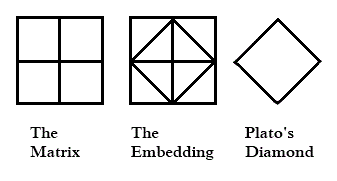
From a post of Sept. 22,
"Binary Opposition Illustrated" —

A symbol of the unity of yin and yang —
Related material:
A much more sophisticated approach to the "deep structure" of the
Meno diagram —

Saturday, September 24, 2016
The Seven Seals
From Hermann Weyl's 1952 classic Symmetry —
"Galois' ideas, which for several decades remained
a book with seven seals but later exerted a more
and more profound influence upon the whole
development of mathematics, are contained in
a farewell letter written to a friend on the eve of
his death, which he met in a silly duel at the age of
twenty-one. This letter, if judged by the novelty and
profundity of ideas it contains, is perhaps the most
substantial piece of writing in the whole literature
of mankind."
Some Galois geometry —
See the previous post for more narrative.
Core Structure
For the director of "Interstellar" and "Inception" —
At the core of the 4x4x4 cube is …

Cover modified.
Thursday, September 22, 2016
Binary Opposition Illustrated
Click the above image for remarks on
"deep structure" and binary opposition.
See also the eightfold cube.
Tuesday, September 20, 2016
Savage Logic
From "The Cerebral Savage," by Clifford Geertz —
(Encounter, Vol. 28 No. 4 (April 1967), pp. 25-32.)

The Diamond Theorem …
As the Key to All Mythologies
For the theorem of the title, see "Diamond Theorem" in this journal.
"These were heavy impressions to struggle against,
and brought that melancholy embitterment which
is the consequence of all excessive claim: even his
religious faith wavered with his wavering trust in his
own authorship, and the consolations of the Christian
hope in immortality seemed to lean on the immortality
of the still unwritten Key to all Mythologies."
— Middlemarch , by George Eliot, Ch. XXIX
Related material from Sunday's print New York Times —
Sunday's Log24 sermon —
See also the Lévi-Strauss "Key to all Mythologies" in this journal,
as well as the previous post.
Monday, September 19, 2016
Squaring the Pentagon
The "points" and "lines" of finite geometry are abstract
entities satisfying only whatever incidence requirements
yield non-contradictory and interesting results. In finite
geometry, neither the points nor the lines are required to
lie within any Euclidean (or, for that matter, non-Euclidean)
space.
Models of finite geometries may, however, embed the
points and lines within non -finite geometries in order
to aid visualization.
For instance, the 15 points and 35 lines of PG(3,2) may
be represented by subsets of a 4×4 array of dots, or squares,
located in the Euclidean plane. These "lines" are usually finite
subsets of dots or squares and not* lines of the Euclidean plane.
Example — See "4×4" in this journal.
Some impose on configurations from finite geometry
the rather artificial requirement that both points and lines
must be representable as those of a Euclidean plane.
Example: A Cremona-Richmond pentagon —
A square version of these 15 "points" —

A 1905 square version of these 15 "points"
with digits instead of letters —
See Parametrizing the 4×4 Array
(Log24 post of Sept. 13, 2016).
Update of 8 AM ET Sunday, Sept. 25, 2016 —
For more illustrations, do a Google image search
on "the 2-subsets of a 6-set." (See one such search.)
* But in some models are subsets of the grid lines
that separate squares within an array.
Saturday, September 17, 2016
Friday, September 16, 2016
A Counting-Pattern
Thursday, September 15, 2016
The Smallest Perfect Number/Universe
The smallest perfect number,* six, meets
"the smallest perfect universe,"** PG(3,2).
* For the definition of "perfect number," see any introductory
number-theory text that deals with the history of the subject.
** The phrase "smallest perfect universe" as a name for PG(3,2),
the projective 3-space over the 2-element Galois field GF(2),
was coined by math writer Burkard Polster. Cullinane's square
model of PG(3,2) differs from the earlier tetrahedral model
discussed by Polster.
Tuesday, September 13, 2016
Parametrizing the 4×4 Array
The previous post discussed the parametrization of
the 4×4 array as a vector 4-space over the 2-element
Galois field GF(2).
The 4×4 array may also be parametrized by the symbol
0 along with the fifteen 2-subsets of a 6-set, as in Hudson's
1905 classic Kummer's Quartic Surface —
Hudson in 1905:
These two ways of parametrizing the 4×4 array — as a finite space
and as an array of 2-element sets — were related to one another
by Cullinane in 1986 in describing, in connection with the Curtis
"Miracle Octad Generator," what turned out to be 15 of Hudson's
1905 "Göpel tetrads":
A recap by Cullinane in 2013:
Click images for further details.
Monday, September 12, 2016
The Kummer Lattice
The previous post quoted Tom Wolfe on Chomsky's use of
the word "array."
An example of particular interest is the 4×4 array
(whether of dots or of unit squares) —
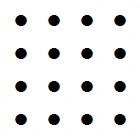
 .
.
Some context for the 4×4 array —
The following definition indicates that the 4×4 array, when
suitably coordinatized, underlies the Kummer lattice .

Further background on the Kummer lattice:
Alice Garbagnati and Alessandra Sarti,
"Kummer Surfaces and K3 surfaces
with $(Z/2Z)^4$ symplectic action."
To appear in Rocky Mountain J. Math. —
The above article is written from the viewpoint of traditional
algebraic geometry. For a less traditional view of the underlying
affine 4-space from finite geometry, see the website
Finite Geometry of the Square and Cube.
Some further context …
"To our knowledge, the relation of the Golay code
to the Kummer lattice … is a new observation."
— Anne Taormina and Katrin Wendland,
"The overarching finite symmetry group of
Kummer surfaces in the Mathieu group M24 "
As noted earlier, Taormina and Wendland seem not to be aware of
R. W. H. T. Hudson's use of the (uncoordinatized*) 4×4 array in his
1905 book Kummer's Quartic Surface. The array was coordinatized,
i.e. given a "vector space structure," by Cullinane eight years prior to
the cited remarks of Curtis.
* Update of Sept. 14: "Uncoordinatized," but parametrized by 0 and
the 15 two-subsets of a six-set. See the post of Sept. 13.
Friday, September 9, 2016
There IS such a thing …
http://gregegan.customer.netspace.net.au/APPLETS/29/NonSimple4E.gif
See also Dueling Formulas, Sinner or Saint?, and The Zero Obit.
Wednesday, September 7, 2016
Grammar and Patterns
"May, / The months [sic ] of understanding" — Wallace Stevens
Saturday, May 21, 2016
|
|
"If pure mathematics does spring from sub-conscious intuitions— already deep-structured as are grammatical patterns in the transformational-generative theory of language?— if the algebraic operation arises from wholly internalized pattern-weaving, how then can it, at so many points, mesh with, correspond to, the material forms of the world?"
— Steiner, George. Grammars of Creation |
Good question.
See Bedtime Story (Sept. 1, 2016).
Tuesday, September 6, 2016
Ethno-Aesthetics
"Lévi-Strauss is an infatuated aesthetician."
— Boris Wiseman, Lévi-Strauss, Anthropology and Aesthetics ,
Cambridge University Press, 2007, p. 27
Last night's link from the Piper Laurie image leads to …

Related theoretical material — See Hudson + Tetrahedra.
Monday, September 5, 2016
Structural Study
The Lévi-Strauss “canonic formula” of myth in its original 1955 context,
described as that of permutation groups —

Related material in this journal —
Dueling Formulas and Symmetry.
Saturday, September 3, 2016
Resplendent Triviality
Wednesday, August 31, 2016
The Lost Crucible
Yesterday's post The Eightfold Cube in Oslo suggests a review of
posts that mention The Lost Crucible.
(The crucible in question is from a book by Katherine Neville,
The Eight . Any connection with Arthur Miller's play "The Crucible"
is purely coincidental.)
Tuesday, August 30, 2016
The Eightfold Cube in Oslo
A KUNSTforum.as article online today (translation by Google) —
Update of Sept. 7, 2016: The corrections have been made,
except for the misspelling "Cullinan," which was caused by
Google translation, not by KUNSTforum.
Saturday, August 27, 2016
Folk Answer
(A sequel to "Folk Question ," the previous post)
See also Alexandra Bellow's "Flashbacks of a Mathematical Life"
in the September 2016 Notices of the American Mathematical Society .
Folk Question
A figure from Dec. 27, 2003 —

Quoted here on that date —
“If little else, the brain is an educational toy."
— Tom Robbins, Even Cowgirls Get the Blues
"What else did you get for Christmas?"
— Folk question
Incarnation
See a search for the title in this journal.
Related material:
The incarnation of three permutations,
named A, B, and C,
on the 7-set of digits {1, 2, 3, 4, 5, 6, 7}
as permutations on the eightfold cube.
See Minimal ABC Art, a post of August 22, 2016.
Friday, August 26, 2016
Structure a Set, Set a Structure
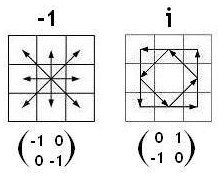
A star figure and the Galois quaternion.
The square root of the former is the latter.
See also a search in this journal for "Set a Structure."
Wednesday, August 24, 2016
Core Statements
"That in which space itself is contained" — Wallace Stevens
An image by Steven H. Cullinane from April 1, 2013:
The large Desargues configuration of Euclidean 3-space can be
mapped canonically to the 4×4 square of Galois geometry —
On an Auckland University of Technology thesis by Kate Cullinane —

The thesis reportedly won an Art Directors Club award on April 5, 2013.
Tuesday, August 23, 2016
Puritan Contemplation:
For an authority on Japanese art —
Text Tiles*

Compare to and contrast with …
Remarks on art, contemplation. and Puritanism
from a recent Princeton University Press book —
“Lucy Lippard distinguished Asian art
(ego-less and contemplative)
from New York Minimalism
(moralistic and puritanical).”
— Mathematics and Art ,
Princeton U. Press, Fall 2015
* Update of Aug. 24, 2016 — See also Nov. 2, 2014.
Monday, August 22, 2016
Minimal ABC Art
Sunday, August 21, 2016
Imperium Emporium
Review
Fugue No. 21
B-Flat Major
Well-Tempered Clavier Book II
Johann Sebastian Bach
by Timothy A. Smith
Theme and Variations
by Steven H. Cullinane
The beginning of each —
Some context —
Friday, August 19, 2016
1947 Opening
| 1. e4 |
See also Geometry of the I Ching and "Miracle on 34th Street." |
Tuesday, August 16, 2016
Midnight Narrative
The images in the previous post do not lend themselves
to any straightforward narrative. Two portions of the
large image search are, however, suggestive —

Cross and Boolean lattice.
The improvised cross in the second pair of images
is perhaps being wielded to counteract the
Boole of the first pair of images. See the heading
of the webpage that is the source of the lattice
diagram toward which the cross is directed —
Update of 10 am on August 16, 2016 —
See also Atiyah on the theology of
(Boolean) algebra vs. (Galois) geometry:

Sunday, August 14, 2016
The Boole-Galois Games
Continued from earlier posts on Boole vs. Galois.

From a Google image search today for “Galois Boole.”
Click the image to enlarge it.
Friday, August 12, 2016
Dustbucket Physics
Peter Galison, a Harvard professor, is a defender of
the Vienna Circle and the religion of Scientism.
From Galison's “Structure of Crystal, Bucket of Dust,” in
Circles Disturbed: The Interplay of Mathematics and Narrative ,
edited by Apostolos Doxiadis and Barry Mazur, pp. 52-78
(Princeton: Princeton U. Press, 2012) …
Galison's final paragraph —
"Perhaps, then, it should not surprise us too much if,
as Wheeler approaches the beginning-end of all things,
there is a bucket of Borelian dust. Out of this filth,
through the proposition machine of quantum mechanics
comes pregeometry; pregeometry makes geometry;
geometry gives rise to matter and the physical laws
and constants of the universe. At once close to and far
from the crystalline story that Bourbaki invoked,
Wheeler’s genesis puts one in mind of Genesis 3:19:
'In the sweat of thy face shalt thou eat bread, till thou
return unto the ground; for out of it wast thou taken:
for dust thou art, and unto dust shalt thou return.' "
For fans of Scientism who prefer more colorful narratives —

Thursday, August 11, 2016
The Large Desargues Configuration
(Continued from April 2013 and later)
This is what I called "the large Desargues configuration"
in posts of April 2013 and later.
Wednesday, August 10, 2016
Narratives
The novel Blood on Snow , set in Oslo, was published
by Knopf on April 7, 2015. This journal on that date —
|
Log24 on Tuesday, April 7, 2015 Filed under: Uncategorized — m759 @ 7:00 PM Seven years ago in this journal — |
A related image —

Tuesday, August 9, 2016
Sunday, August 7, 2016
A Talisman for Finkelstein
The late physicist David Ritz Finkelstein on the magic square
in Dürer's "Melencolia I" —
"As a child I wondered why such a square was called magic.
The Occult Philosophy [of Agrippa] answers this question
at least. They were used as magical talismans."
The correspondence in the previous post between
Figures A and B may serve as a devotional talisman
in memory of Finkelstein, a physicist who, in the sort of
magical thinking enjoyed by traditional Catholics, might
still be lingering in Purgatory.
See also this journal on the date of Finkelstein's death —
Saturday, August 6, 2016
Mystic Correspondence:
The Cube and the Hexagram
The above illustration, by the late Harvey D. Heinz,
shows a magic cube* and a corresponding magic
hexagram, or Star of David, with the six cube faces
mapped to the six hexagram lines and the twelve
cube edges mapped to the twelve hexagram points.
The eight cube vertices correspond to eight triangles
in the hexagram (six small and two large).
Exercise: Is this noteworthy mapping** of faces to lines,
edges to points, and vertices to triangles an isolated
phenomenon, or can it be viewed in a larger context?
* See the discussion at magic-squares.net of
"perimeter-magic cubes"
** Apparently derived from the Cube + Hexagon figure
discussed here in various earlier posts. See also
"Diamonds and Whirls," a note from 1984.
Friday, August 5, 2016
Sleight of Post
From an earlier Log24 post —
Friday, July 11, 2014
|
From a post of the next day, July 12, 2014 —
"So there are several different genres and tones
jostling for prominence within Lexicon :
a conspiracy thriller, an almost abstract debate
about what language can do, and an ironic
questioning of some of the things it’s currently used for."
— Graham Sleight in The Washington Post
a year earlier, on July 15, 2013
For the Church of Synchronology, from Log24 on the next day —
From a post titled Circles on the date of Marc Simont's death —
See as well Verhexung in this journal.
Monday, August 1, 2016
Cube
From this journal —
See (for instance) Sacred Order, July 18, 2006 —
From a novel published July 26, 2016, and reviewed
in yesterday's (print) New York Times Book Review —
|
The doors open slowly. I step into a hangar. From the rafters high above, lights blaze down, illuminating a twelve-foot cube the color of gunmetal. My pulse rate kicks up. I can’t believe what I’m looking at. Leighton must sense my awe, because he says, “Beautiful, isn’t it?” It is exquisitely beautiful. At first, I think the hum inside the hangar is coming from the lights, but it can’t be. It’s so deep I can feel it at the base of my spine, like the ultralow-frequency vibration of a massive engine. I drift toward the box, mesmerized.
— Crouch, Blake. Dark Matter: A Novel |
See also Log24 on the publication date of Dark Matter .
Saturday, July 30, 2016
Binary
"Benedict Cumberbatch Says a Journey
From Fact to Faith Is at the Heart of Doctor Strange"
— io9 yesterday
" 'This man comes from a binary universe where it’s all about logic,'
the actor told us at San Diego Comic-Con . . . .
'And there’s a lot of humor in the collision between Easter [sic ]
mysticism and Western scientific, sort of logical binary.' "
Related material — Strange Awards, April 14, 2016.
I prefer a different sort of journey. See Boole vs. Galois.
Thursday, July 28, 2016
Monday, July 25, 2016
The Retinoid Self

"… which grounds the self" . . .
Popular Mechanics online today —
"Verizon exec Marni Walden seemed to
indicate Mayer's future may still be up in the air."
See also 5×5 in this journal —

"If you have built castles in the air,
your work need not be lost;
that is where they should be.
Now put the foundations under them.”
— Henry David Thoreau
Sunday, July 24, 2016
Point Omega …
In this post, "Omega" denotes a generic 4-element set.
For instance … Cullinane's
or Schmeikal's
 .
.
The mathematics appropriate for describing
group actions on such a set is not Schmeikal's
Clifford algebra, but rather Galois's finite fields.
Saturday, July 23, 2016
But Seriously …
Those who want a serious approach to the mathematics
of Clifford algebras — via finite geometry, the natural setting
of the four-group of the previous post — should consult
"Finite Geometry, Dirac Groups and the Table of
Real Clifford Algebras," by Ron Shaw (1995).
Thursday, July 21, 2016
Image Search
Wednesday, July 20, 2016
Weather for Jews
"What I'm aiming for are moments of strong sensation —
moments of total physical experience of the landscape,
when weather just reaches out and sucks you in."
— The late Jane Wilson —
See also the previous post and, from the date of Wilson's death,
Tuesday, July 19, 2016
Interior, Exterior
The post Outer, Inner of July 16, 2016, contained the following
illustration of a quote from "An Ordinary Evening in New Haven" —

An image from yesterday morning pictured a link to the
Feb. 10, 2014, post Mystery Box III: Inside, Outside.
That post, shown below, offers a deeper interpretation of the
Stevens quote "an interior made exterior."
(Click image below to use the post's links.)
Saturday, July 16, 2016
The Midnight Beginning
From the midnight beginning June 27, 2016 —
This review of the above post was suggested by the
Galois-related footnote in the previous post and by
an obituary in this morning's online New York Times .
See as well a July 6 obituary for the same person in
The Martha's Vineyard Times .
Binary Shema: The “O” and the “I”
The "I" of "I Am that I Am" has been described as a creation of
an "ur-unity" (see the Anderson passage below) and this ur-unity,
denoted by "O," has been described elsewhere as "a primary reality"
(see the Sullivan passage below). These descriptions are of course
much less clear than those usually given for the similar purely
mathematical * notations "0" and "1."
See also Quine's Shema in "Is Nothing Sacred?" —
0! = 1.
Quoted here on July 30, 2015 —

Linked to here on June 29, 2016 —

* Note for mathematicians: Here characteristic 0 is assumed .
Quine's Shema does not apply to Galois.
Friday, July 15, 2016
Autistic Enchantment*
Robert Nye, author of the novel Falstaff , reportedly died
at 77 on July 2, 2016.
Harvey D. Heinz, expert on magic squares, cubes,
tesseracts, etc., reportedly died at 82 on July 6, 2013.
In memoriam —
From the date of Nye's death:
From Nye's book:
From the date of Heinz's death:
* See also a search for the title in this journal.
Thursday, July 14, 2016
Symmetries and Correspondences
The title is that of a large-scale British research project
in mathematics. On a more modest scale …
"Hanks + Cube" in this journal —
Meditation from an April 1
Related material from the same day —
See also …
Cube Bricks 1984 —
The above bricks appeared in some earlier Log24 posts.
Midnight Special
|
"Poincaré said that science is no more a collection of facts than a house is a collection of bricks. The facts have to be ordered or structured, they have to fit a theory, a construct (often mathematical) in the human mind. … Mathematics may be art, but to the general public it is a black art, more akin to magic and mystery. This presents a constant challenge to the mathematical community: to explain how art fits into our subject and what we mean by beauty. In attempting to bridge this divide I have always found that architecture is the best of the arts to compare with mathematics. The analogy between the two subjects is not hard to describe and enables abstract ideas to be exemplified by bricks and mortar, in the spirit of the Poincaré quotation I used earlier."
— Sir Michael Atiyah, "The Art of Mathematics" |
A post from this journal later in 2010 —
The above post's date — May 20, 2010 — was
the date of death for mathematician Walter Rudin.
The above post from that date has a link to the
Heinlein story "And He Built a Crooked House."
A not-so-crooked house —
Wednesday, July 13, 2016
Tuesday, July 12, 2016
Klein and Kummer Configurations in 1889
Further details from Edmund Hess in 1889* related to
last night's remarks on the Klein 6015 configuration
and the Kummer 166 configuration —
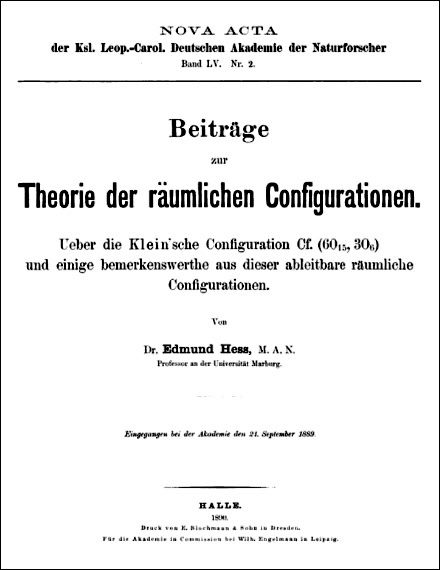
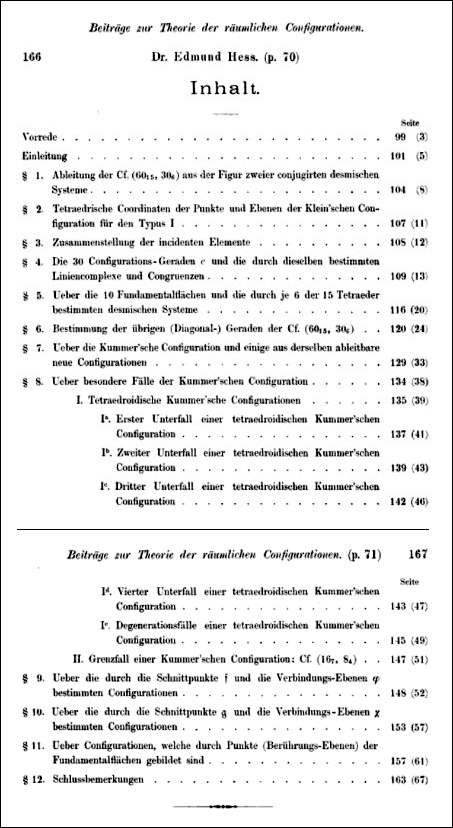
* Edmund Hess, "Beiträge zur Theorie der räumlichen Configurationen.
Ueber die Klein'sche Configuration Cf. (60₁₅, 30₆) und einige
bemerkenswerthe aus dieser ableitbare räumliche Configurationen."
Group Elements and Skew Lines
The following passage by Igor Dolgachev (Good Friday, 2003)
seems somewhat relevant (via its connection to Kummer's 166 )
to previous remarks here on Dirac matrices and geometry —
Note related remarks from E. M. Bruins in 1959 —
Thursday, June 30, 2016
Rubik vs. Galois: Preconception vs. Pre-conception
From Psychoanalytic Aesthetics: The British School ,
by Nicola Glover, Chapter 4 —
|
In his last theoretical book, Attention and Interpretation (1970), Bion has clearly cast off the mathematical and scientific scaffolding of his earlier writings and moved into the aesthetic and mystical domain. He builds upon the central role of aesthetic intuition and the Keats's notion of the 'Language of Achievement', which
… includes language that is both Bion distinguishes it from the kind of language which is a substitute for thought and action, a blocking of achievement which is lies [sic ] in the realm of 'preconception' – mindlessness as opposed to mindfulness. The articulation of this language is possible only through love and gratitude; the forces of envy and greed are inimical to it.. This language is expressed only by one who has cast off the 'bondage of memory and desire'. He advised analysts (and this has caused a certain amount of controversy) to free themselves from the tyranny of the past and the future; for Bion believed that in order to make deep contact with the patient's unconscious the analyst must rid himself of all preconceptions about his patient – this superhuman task means abandoning even the desire to cure . The analyst should suspend memories of past experiences with his patient which could act as restricting the evolution of truth. The task of the analyst is to patiently 'wait for a pattern to emerge'. For as T.S. Eliot recognised in Four Quartets , 'only by the form, the pattern / Can words or music reach/ The stillness'.30. The poet also understood that 'knowledge' (in Bion's sense of it designating a 'preconception' which blocks thought, as opposed to his designation of a 'pre -conception' which awaits its sensory realisation), 'imposes a pattern and falsifies'
For the pattern is new in every moment The analyst, by freeing himself from the 'enchainment to past and future', casts off the arbitrary pattern and waits for new aesthetic form to emerge, which will (it is hoped) transform the content of the analytic encounter. 29. Attention and Interpretation (Tavistock, 1970), p. 125 30. Collected Poems (Faber, 1985), p. 194. 31. Ibid., p. 199. |
See also the previous posts now tagged Bion.
Preconception as mindlessness is illustrated by Rubik's cube, and
"pre -conception" as mindfulness is illustrated by n×n×n Froebel cubes
for n= 1, 2, 3, 4.
Suitably coordinatized, the Froebel cubes become Galois cubes,
and illustrate a new approach to the mathematics of space .
Wednesday, June 29, 2016
Space Jews
For the Feast of SS. Peter and Paul —

In memory of Alvin Toffler and Simon Ramo,
a review of figures from the midnight that began
the date of their deaths, June 27, 2016 —
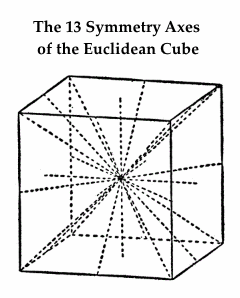

The 3×3×3 Galois Cube
See also Rubik in this journal.
The Mystery of O
"The domain of O has been explored by philosophers and mystics
under titles like the Absolute, Ultimate Reality or Ultimate Truth,
the Ground of Being, God or the godhead. O is the world of Plato’s
ideal forms, Kant’s things-in-themselves, Bion’s pre-conceptions,
Klein’s inborn phantasies and Jung’s archetypes."
— Barbara Stevens Sullivan on page 38 of her book
The Mystery of Analytical Work: Weavings from Jung and Bion ,
Routledge first edition, 2010
See also Bion in The Search for Charles Wallace, and …
Click on the image for some context.
Monday, June 27, 2016
Interplay
From a search in this journal for Euclid + Galois + Interplay —


The 3×3×3 Galois Cube
A tune suggested by the first image above —

Sunday, June 26, 2016
Common Core versus Central Structure
Rubik's Cube Core Assembly — Swarthmore Cube Project, 2008 —
"Children of the Common Core" —
There is also a central structure within Solomon's Cube —

For a more elaborate entertainment along these lines, see the recent film
"Midnight Special" —
Tuesday, June 21, 2016
The Central Structure
“The central poem is the poem of the whole,
The poem of the composition of the whole”
— Wallace Stevens, “A Primitive like an Orb”
The symmetries of the central four squares in any pattern
from the 4×4 version of the diamond theorem extend to
symmetries of the entire pattern. This is true also of the
central eight cubes in the 4×4×4 Solomon’s cube .
